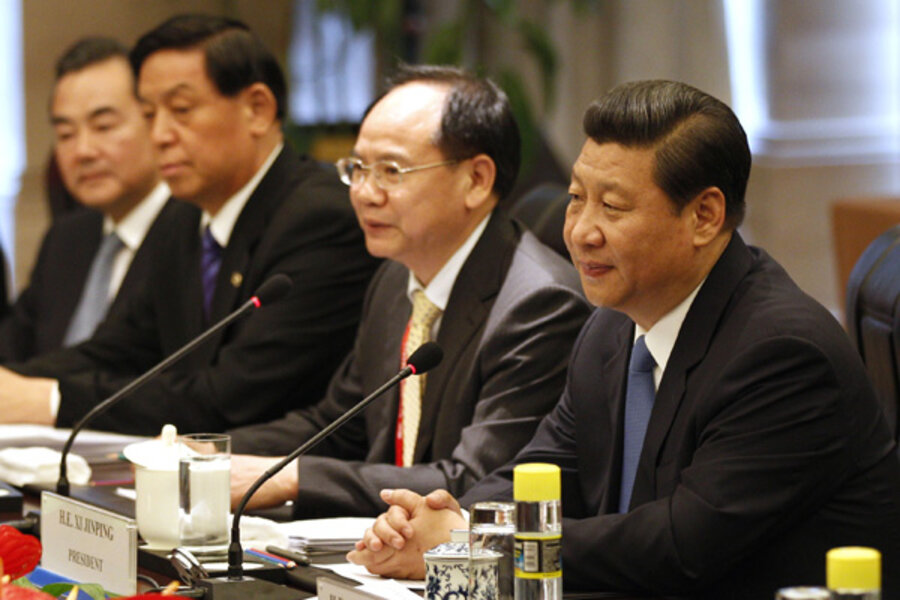Friend or frenemy? For China, key issue is how US really views it
Loading...
| Beijing
On his first visit to Beijing as US secretary of State, John Kerry may find himself this weekend mostly doing a fireman’s work in a bid to dampen the Korean crisis.
He would be well advised, though, analysts in Washington and Beijing agree, to spend some time addressing a potentially much more dangerous problem: the deepening distrust that dogs the two nations’ relationship.
“We have lots of channels of communication with China and very frank discussions,” says Bonnie Glaser, a China watcher at the Center for Strategic and International Studies, a Washington think tank. “But when it comes to each others’ long-term intentions, the strategic mistrust is as deep as ever.”
The relationship between China and the United States is “sweet and sour,” adds Sun Zhe, who teaches International Relations at Tsinghua University in Beijing. “We have built a framework for dialogue, but the problem is how to make the relationship work.”
China and the United States rub up against each other in myriad fields, from charges of industrial cyberespionage, trade disputes, and accusations of copyright infringement to complaints about investment curbs, territorial disagreements, and differences over how to combat climate change.
These frictions can be managed even if they cannot always be resolved, says Kenneth Lieberthal, a senior fellow at the Brookings Institution in Washington. More worrying, he says, is that “there has been less strategic trust recently, and that is very hard to turn around.”
What are you really up to?
At the heart of the problem are conflicting views about what each side is up to in the Asia-Pacific region, and more broadly in the world.
Washington is fearful of how China plans to use the military might it is amassing, in view of Beijing’s recent bullying behavior in territorial disputes with its neighbors, says Ms. Glaser. “We have growing worries about the potential for China to use coercion to protect its interests at the expense of others.”
Beijing, on the other hand, she says, “continues to suspect that the US is seeking to slow or halt China’s rise as a great power.”
Fueling such suspicions is the Obama administration’s “pivot to Asia,” a rebalancing of American military and diplomatic resources toward the region, which many policymakers here believe is a new bid to encircle China.
From a White House perspective, explains Dr. Lieberthal, “China is at the center of the rebalancing-to-Asia strategy because China is at the center of Asia. For China, the question is whether they are not the center but the bullseye.”
“Without strategic trust, the American rebalancing will be seen by the Chinese public and by policymakers as targeted at China,” says Professor Sun.
Differing over how to build trust
How that trust might be nurtured is a matter of dispute.
Mindful, perhaps, of the consequences of Germany’s rise in the early 20th century, Washington has taken up Chinese President Xi Jinping’s proposal that the two giants map out a new type of big-power relationship, so as to avert the risk of an emerging power clashing with an established one.
There is not, however, very much meat yet on the bare bones of this vision. “The problem now is how we fill this new relationship with concrete elements,” says Liu Feitao, deputy head of American Studies at the China Institute of International Studies, a think tank linked to the Chinese foreign ministry. “That will be Mr. Kerry’s big task.”
For US policymakers, building this new model and fostering trust will require “practical cooperation on issues that matter to both sides,” as Tom Donilon, President Obama’s national security adviser, said in a speech last month.
“You get reassurance when both sides show each other that they can deal with issues without taking aim at each other,” adds Lieberthal.
But Beijing starts from another perspective, says Dr. Liu. “China puts more emphasis on whether you define me as a friend, an enemy, or a frenemy,” he explains. “Depending on the definition, China will give different responses to US demands on specific issues such as cyberespionage or regional problems.”
The North Korea factor
The results of these differing approaches are evident in the current crisis over North Korea’s threats to launch nuclear strikes against the United States and its ally, South Korea.
“If China and the US could really cooperate to denuclearize the Korean peninsula, that would have a profound impact on other areas of the relationship,” says Glaser. But in fact there has been no joint action between Beijing and Washington since the crisis erupted three weeks ago.
Indeed, President Xi launched a side-swipe at the US in a speech last Sunday that Chinese analysts said was aimed at both Pyongyang and Washington, warning that “no one should be allowed to throw a region and even the whole world into chaos for selfish gains.” (For more insight, read: China's Xi signals limited shift away from North Korea)
Many Chinese foreign policy scholars partly blame the current US war games in South Korea for the current crisis.
US officials have taken every opportunity to try to reassure China that Washington’s renewed attention to Asian affairs should not be seen as a threat. In his recent speech, Mr. Donilon declared that rebalancing “does not mean containing China,” and specified for the first time, according to Chinese scholars, that “building a stable, productive, and constructive relationship with China” was one of the four pillars of the US administration’s Asia policy.
That went down well in Beijing.
“It indicates maybe that the US might have realized that the success of its strategy in the Asia Pacific region does not depend just on how many small countries stand alongside America,” says Liu. “If the US puts those words into concrete action and policy design, this is a significant and positive change.”






